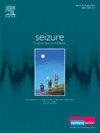Intravenous perampanel in clinical practice: A multicenter prospective registry study
IF 2.8
3区 医学
Q2 CLINICAL NEUROLOGY
引用次数: 0
Abstract
Purpose
This study aimed to evaluate the efficacy and safety of intravenous perampanel (IV-PER) in routine clinical practice.
Methods
Patients who received IV-PER at Nagoya University Hospital or one of the 21 affiliated institutions between June 2024 and March 2025 were included. Indications for IV-PER included treatment for epileptic seizures, particularly acute symptomatic seizures, and prophylactic use before or after surgery. The primary endpoint was the seizure suppression rate within 7 days of treatment initiation, and the secondary endpoint was the incidence of adverse events (AEs). Clinical data were recorded daily, and blood tests were conducted within 2 weeks of administration. Enrolled patients were categorized into three groups based on the underlying etiology: cerebrovascular disease (CD), brain tumor (BT), and traumatic brain injury (TBI). Treatment efficacy and safety were assessed across these groups.
Results
Of the 237 patients, 74, 116, and 47 were classified into the CD, BT, and TBI groups, respectively. The overall seizure suppression rate within 7 days was 89.0 %. Rates by group were 87.8 % (CD), 96.6 % (BT), and 72.3 % (TBI). When stratified by indication, the rates were 99.3 % for prophylactic use, 69.4 % for focal seizures, and 74.4 % for generalized seizures. Regarding AEs, somnolence was reported in 3 patients and irritability in one. Laboratory abnormalities included anemia, elevated liver enzymes, elevated creatine kinase, and hyponatremia. A total of 71 patients experienced one of these.
Conclusions
This large multicenter prospective registry demonstrates that IV-PER can be safely used for seizure management during the 7-day acute phase in real-world clinical settings.
静脉注射perampanel的临床应用:一项多中心前瞻性注册研究
目的评价静脉注射perampanel (IV-PER)在临床常规应用中的有效性和安全性。方法纳入2024年6月至2025年3月在名古屋大学附属医院或21家附属机构之一接受IV-PER治疗的患者。IV-PER的适应症包括治疗癫痫发作,特别是急性症状性发作,以及在手术前或手术后预防性使用。主要终点是治疗开始后7天内癫痫发作抑制率,次要终点是不良事件(ae)的发生率。每天记录临床资料,并在给药2周内进行血液检查。纳入的患者根据潜在病因分为三组:脑血管疾病(CD)、脑肿瘤(BT)和创伤性脑损伤(TBI)。对这些组的治疗效果和安全性进行评估。结果237例患者中,CD组74例,BT组116例,TBI组47例。7天内癫痫发作抑制率为89.0%。组间发病率分别为:CD(87.8%)、BT(96.6%)、TBI(72.3%)。当按适应症分层时,预防性使用的发生率为99.3%,局灶性发作的发生率为69.4%,全局性发作的发生率为74.4%。不良反应中,嗜睡3例,烦躁1例。实验室异常包括贫血、肝酶升高、肌酸激酶升高和低钠血症。共有71名患者经历了其中一种。结论:这项大型多中心前瞻性研究表明,IV-PER在现实世界的临床环境中可以安全地用于7天急性期的癫痫发作管理。
本文章由计算机程序翻译,如有差异,请以英文原文为准。
求助全文
约1分钟内获得全文
求助全文
来源期刊

Seizure-European Journal of Epilepsy
医学-临床神经学
CiteScore
5.60
自引率
6.70%
发文量
231
审稿时长
34 days
期刊介绍:
Seizure - European Journal of Epilepsy is an international journal owned by Epilepsy Action (the largest member led epilepsy organisation in the UK). It provides a forum for papers on all topics related to epilepsy and seizure disorders.
 求助内容:
求助内容: 应助结果提醒方式:
应助结果提醒方式:


